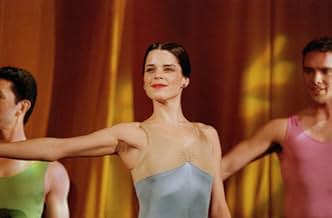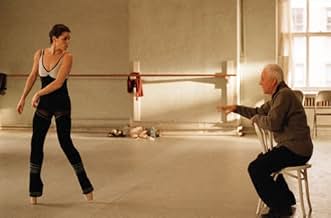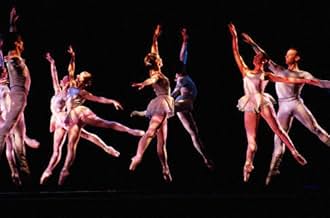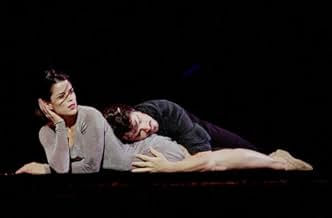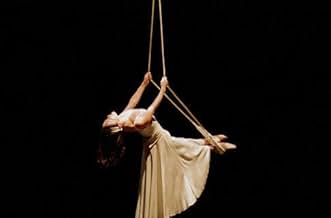IMDb रेटिंग
6.2/10
7 हज़ार
आपकी रेटिंग
अपनी भाषा में प्लॉट जोड़ेंA young ballet dancer is poised to become the principal performer in a group of ballet dancers.A young ballet dancer is poised to become the principal performer in a group of ballet dancers.A young ballet dancer is poised to become the principal performer in a group of ballet dancers.
- पुरस्कार
- 2 कुल नामांकन
Barbara E. Robertson
- Harriet
- (as Barbara Robertson)
Davis C. Robertson
- Alec - Joffrey Dancer
- (as Davis Robertson)
फ़ीचर्ड समीक्षाएं
Some of the dances are tiny religious experiences. The film doesn't look nearly as good as some of Altman's others, but there are flashes of awesome beauty: a topless male dancer alone in a room with golden beams of light, and Neve Campbell in her bath. The movie looks at the queeny pretensions of the boys (and their fathers), the dancers' sex lives (who are more '60s than their instructor knows), and the company leader, played by Malcolm McDowell, whose occasional flakiness is caught by one black dancer. I couldn't help but think of McDowell as an Altman self-criticism: an elderly director working with small budgets, prone to artiness, who champions art as being organic, who rounds up a large crew of performers and calls them "babies." The day-in-the-life shapelessness of the movie didn't at all bother me, though one character, who asks to stay in a dancer's apartment, is dropped pretty quickly. And James Franco is in it. 9/10
George, what I think you meant to say was that you are actually a thick-headed mocho-man who has NO appreciation for the arts whatsoever. If you did, you'd understand that the ballet dancing in this movie was beautiful, and entitled a lot of hard work on the dancers' part. I've danced since I was three, and have met many male dancers along the way, and, to inform you, NOT ONE OF THEM WAS GAY! I'm a STRAIGHT female who has dated a male dancer before. Assumptions like that are completely childish. THe acting, dancing, setting, and costumes in this movie were wonderful. If you can't even appreciate fine movie-making, then you are surely at a loss. Even if you would rather be watching sports, which I completely understand, most men would, that's fine: however, it doesn't give you the right to judge an a form of art that you abviously don't understand.
Lets hope that Altman makes films for another 20 years and that he stays as adventuresome as he currently is.
In 'The Long Goodbye' Altman invented a rather new camera stance, literally asking the actors to improvise staging and having the camera discovering them.
It took a few decades for him to get back to such experiments with 'Gosford.' Now he takes it even further with perhaps the purest problem in film cinematography: how do you film dance?
Forget that this features Campbell in a vanity role: she is good enough and doesn't detract. Forget about any modicum of plot: there isn't any. And unlike 'Nashville' or the similarly selfreferential 'Player' there is no cynical commentary.
The commentary itself is selfreferential this time. Yes, this time the center of the film is how 'Mr A' orchestrates movement and images. This is most of all about himself, and is far, far more intelligent and subtle than say, 'Blowup.'
But along the way, you get possibly the best dance experience on film. That's because they've been able to use many cameras. There are not as many as 'Dancer in the Dark,' but each camera dances, engages with the dance and the dance of people and objects around the dance. So we get four layers of dance: the actual ballet, the orchestration of people around the production, the dancing cameras (enhanced by non-radical appearing radical editing) and the dance within the mind of Mr A who encourages, follows and captures them all.
Ted's Evaluation -- 3 of 3: Worth watching.
In 'The Long Goodbye' Altman invented a rather new camera stance, literally asking the actors to improvise staging and having the camera discovering them.
It took a few decades for him to get back to such experiments with 'Gosford.' Now he takes it even further with perhaps the purest problem in film cinematography: how do you film dance?
Forget that this features Campbell in a vanity role: she is good enough and doesn't detract. Forget about any modicum of plot: there isn't any. And unlike 'Nashville' or the similarly selfreferential 'Player' there is no cynical commentary.
The commentary itself is selfreferential this time. Yes, this time the center of the film is how 'Mr A' orchestrates movement and images. This is most of all about himself, and is far, far more intelligent and subtle than say, 'Blowup.'
But along the way, you get possibly the best dance experience on film. That's because they've been able to use many cameras. There are not as many as 'Dancer in the Dark,' but each camera dances, engages with the dance and the dance of people and objects around the dance. So we get four layers of dance: the actual ballet, the orchestration of people around the production, the dancing cameras (enhanced by non-radical appearing radical editing) and the dance within the mind of Mr A who encourages, follows and captures them all.
Ted's Evaluation -- 3 of 3: Worth watching.
"The Company" is a lovely commercial for the Joffrey Ballet of Chicago (for New Yorkers this is in fact the same modern ballet company that used to be based at City Center but left the competitive dance fund raising environment here to have the stage to itself in Chicago).
A labor of love for producer/story writer/star/former dancer Neve Campbell, she was determined to make the first film about a whole company, not just using the dance world for a backdrop of individual melodrama, and with long passages of actual performances. So she brought in the primo director of ensembles, Robert Altman. But clearly she made compromises to get the film made that put his creativity as a director in a straight jacket and only lets his trademark talents fleetingly shine through.
The key was getting the Joffrey's cooperation and I can only imagine the tough negotiations that resulted in this pretty much being a whitewash of the ballet world, or of any creative endeavor, in sharp contrast to the behind-the-scenes reality shows "Project Greenlight" on HBO or "The Fire Within" about Cirque du Soleil's "Varekai" that was on Bravo. I surmise a long list of thou shalt not's that appear to include items such as:
-- no views of the non-artistic administrators, board, or fund raisers (there's a passing exhortation to a flashy choreographer Robet Desrosiers to stay within the budget, but he gets the complicated costumes and sets he wants anyway);
-- no homosexual relationships (there's a passing reference to the dancers AIDS has taken including "Bob", which cognoscenti have to know refers to the company's founder Robert Jeffrey, and Malcolm McDowall as the egotistical artistic director "Alberto Antonelli," a stand-in presumably for current company director Gerald Arpino, urges fellow Italian-American men not to make their boys, like he had to, "hide their ballet shoes");
-- no eating disorders (we do twice hear "Mr. A," half-jokingly, urge the company to eat salads and vegetables and there's one fast, quiet exchange in passing that I think was about diet pills);
-- blame dancers' problems on dysfunctional parents and mentors, recalling that vivid song from "A Chorus Line" - "Everything was beautiful at the ballet" as dancers seek to escape messy situations through temporary perfect beauty.
Altman does get to assert his artistic priorities in a few ways. He effectively seizes on the ageism in dance, showing that it's not just the tyranny of aging bodies, as would affect any athlete, but that dancers with experience speak up for themselves and are more difficult to control in a viciously autocratic environment than ambitious, financially desperate, and, literally, pliable young dancers.
It's also the first time I've seen a camera expose the swarm of acolyte assistants to the director, revealing them as ex-dancers whom "Mr. A" still dismissively calls "babies" and who resent the new stars even as they dance vicariously through them.
The other beautiful Altman touch is when the significant character developments take place not center stage in a crowd but through a look or line happening way in the corner of the screen, like the expression on James Franco, as Cambell's chef beau, when she avoids introducing him to her family amidst a rush of congratulators.
But visually and musically the Joffrey is a wonderful choice, as the choreographers represented range from Arpino to Alwin Nikolais to Laura Dean and MOMIX. A centerpiece danced by Campbell is a sexy Lar Lubovitch pas de deux to the signature song "My Funny Valentine" which is used as a leitmotif, for reasons that still seem murky to me after hearing Altman explain why on "Charlie Rose," throughout the film in versions also by Elvis Costello, Chet Baker, and the Kronos Quartet. The music ranges from classical to jazz to the ethereal pop of Julee Cruise, Mark O'Connor's in-between "Appalachia Waltz", and the lovely score by Van Dyke Parks.
A labor of love for producer/story writer/star/former dancer Neve Campbell, she was determined to make the first film about a whole company, not just using the dance world for a backdrop of individual melodrama, and with long passages of actual performances. So she brought in the primo director of ensembles, Robert Altman. But clearly she made compromises to get the film made that put his creativity as a director in a straight jacket and only lets his trademark talents fleetingly shine through.
The key was getting the Joffrey's cooperation and I can only imagine the tough negotiations that resulted in this pretty much being a whitewash of the ballet world, or of any creative endeavor, in sharp contrast to the behind-the-scenes reality shows "Project Greenlight" on HBO or "The Fire Within" about Cirque du Soleil's "Varekai" that was on Bravo. I surmise a long list of thou shalt not's that appear to include items such as:
-- no views of the non-artistic administrators, board, or fund raisers (there's a passing exhortation to a flashy choreographer Robet Desrosiers to stay within the budget, but he gets the complicated costumes and sets he wants anyway);
-- no homosexual relationships (there's a passing reference to the dancers AIDS has taken including "Bob", which cognoscenti have to know refers to the company's founder Robert Jeffrey, and Malcolm McDowall as the egotistical artistic director "Alberto Antonelli," a stand-in presumably for current company director Gerald Arpino, urges fellow Italian-American men not to make their boys, like he had to, "hide their ballet shoes");
-- no eating disorders (we do twice hear "Mr. A," half-jokingly, urge the company to eat salads and vegetables and there's one fast, quiet exchange in passing that I think was about diet pills);
-- blame dancers' problems on dysfunctional parents and mentors, recalling that vivid song from "A Chorus Line" - "Everything was beautiful at the ballet" as dancers seek to escape messy situations through temporary perfect beauty.
Altman does get to assert his artistic priorities in a few ways. He effectively seizes on the ageism in dance, showing that it's not just the tyranny of aging bodies, as would affect any athlete, but that dancers with experience speak up for themselves and are more difficult to control in a viciously autocratic environment than ambitious, financially desperate, and, literally, pliable young dancers.
It's also the first time I've seen a camera expose the swarm of acolyte assistants to the director, revealing them as ex-dancers whom "Mr. A" still dismissively calls "babies" and who resent the new stars even as they dance vicariously through them.
The other beautiful Altman touch is when the significant character developments take place not center stage in a crowd but through a look or line happening way in the corner of the screen, like the expression on James Franco, as Cambell's chef beau, when she avoids introducing him to her family amidst a rush of congratulators.
But visually and musically the Joffrey is a wonderful choice, as the choreographers represented range from Arpino to Alwin Nikolais to Laura Dean and MOMIX. A centerpiece danced by Campbell is a sexy Lar Lubovitch pas de deux to the signature song "My Funny Valentine" which is used as a leitmotif, for reasons that still seem murky to me after hearing Altman explain why on "Charlie Rose," throughout the film in versions also by Elvis Costello, Chet Baker, and the Kronos Quartet. The music ranges from classical to jazz to the ethereal pop of Julee Cruise, Mark O'Connor's in-between "Appalachia Waltz", and the lovely score by Van Dyke Parks.
If you're a devoted fan of ballet or modern dance, you'll enjoy "The Company." Neve Campbell is Ry, a young ballerina and the focal point of the movie, which is an almost documentary-like portrayal of a professional ballet company preparing for and delivering spectacular dance performances in Chicago. Campbell is a former professional dancer, so she brings authenticity to her performance. However, despite the casting of Malcolm McDowell as an authoritarian, acid-tongued company director to provide a potential source of dramatic conflict with Campbell's character, there's very little story or dialogue in the whole film. Some of the dialogue is so quiet and natural that you can't really make it out. Directed by the great Robert Altman, "The Company" focuses mostly on dance performances and grueling practices, with a few cliches thrown in (the dancers' struggles to win roles, please the choreographer and make ends meet financially). It all looks very realistic and beautiful, and the drama is only in the dance. There's a sweet, slight love story for Ry and her equally hard-working chef beau, played by James Franco. So enjoy "The Company" on a quiet evening, glass of wine in hand, if you love to watch good dance performances, but not if you want dialogue or plot. Still, kudos to Neve Campbell for getting such a tasteful, lovely, non-commercial movie made.
क्या आपको पता है
- ट्रिवियाNeve Campbell lost thousands of dollars of her own money to ensure that her fellow cast members received their wages.
- गूफ़At about 1:10 while counting during a rehearsal, Harriet skips the 6th count of 8.
- भाव
Alberto Antonelli: Ry, honey, let's scramble some ideas, instead of some asshole who contradicts me.
- क्रेज़ी क्रेडिटAfter the closing credits begin rolling, the dancers continue to take their final bows, and the audience continues to applaud.
टॉप पसंद
रेटिंग देने के लिए साइन-इन करें और वैयक्तिकृत सुझावों के लिए वॉचलिस्ट करें
- How long is The Company?Alexa द्वारा संचालित
विवरण
बॉक्स ऑफ़िस
- बजट
- $1,50,00,000(अनुमानित)
- US और कनाडा में सकल
- $22,83,914
- US और कनाडा में पहले सप्ताह में कुल कमाई
- $93,776
- 28 दिस॰ 2003
- दुनिया भर में सकल
- $64,15,017
- चलने की अवधि
- 1 घं 52 मि(112 min)
- रंग
- ध्वनि मिश्रण
- पक्ष अनुपात
- 2.35 : 1
इस पेज में योगदान दें
किसी बदलाव का सुझाव दें या अनुपलब्ध कॉन्टेंट जोड़ें








